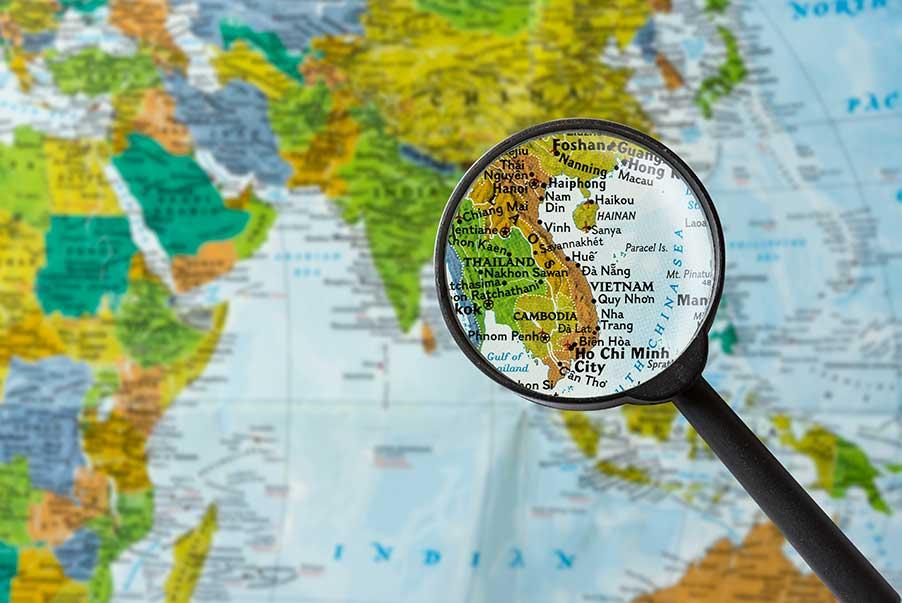On the upswing: Vietnam's political structure explained

On July 2, 1976, Vietnam was reunited after 22 years of division. It was the Vietnam War, in which the United States was also involved, that divided the country. After South Vietnam capitulated unconditionally in 1975, the way was clear for a new political structure in Vietnam.
But what does it look like today? You can find out in the following sections! To understand the political system, however, you first need to know Vietnam's recent history. That is why this or the Vietnam War is briefly outlined. Find out more now – VIETNAM VISA ONLINE has researched for you.
Background knowledge of Vietnam's politics
- The country was divided as a result of the struggle between the Viet Minh and the French occupying forces. The United States had the latter on its side; the Viet Minh was supported by the Chinese.
- The French troops were subject to the "League for the Independence of Vietnam". In March 1954, in the infamous Battle of Dien Bien Phu.
- Henceforth the country was divided (by the Geneva Indochina Conference) on the 17th latitude into South Vietnam and North Vietnam. While the north was considered communist, the south was oriented to the west.
- After the French withdrew from Vietnam, the United States increasingly took over the protection of the south. Constant military clashes with the Northern National Liberation Front followed. The aim of the latter party was the reunification or rather the reintegration of the south with or in North Vietnam.
The importance of these disputes, which culminated in the Vietnam War (around 1955 to 1975), cannot be overestimated for Vietnam's current politics: after massive military losses on all sides, the United States finally withdrew from the war in 1973 (keyword Parisian Agreement). In an official document, the US and North Vietnam declared peace – the two Vietnamese countries should move closer step by step.
Vietnam's politics has often failed
However, the return of peace did not last long, like the struggles between the north and the south soon began again. It was only in the spring of 1975, when North Vietnamese soldiers captured Saigon, that the south capitulated. Shortly afterwards, the country was reunited under communist rule. On July 2, 1976, the founding of the Socialist Republic of Vietnam followed – Vietnam's current political structure.
Socialist Republic of Vietnam = CPV
The ruling and only legal party in the Socialist Republic of Vietnam is the CPV (Abbreviation for Communist Party of Vietnam). Its highest body is a Politburo with 14 members. This is headed by Secretary General Nguyen Phu Trong.
Together with the Secretary General, the Prime Minister and the President (Truong Tan Sang) form the top of the Vietnamese political structure. This trio unanimously makes important decisions in the state. In addition, Truong Tan Sang is the chief of the Vietnam Armed Forces.
"Separation of powers" thanks to the National Assembly
The National Assembly is the top institution in Vietnam's politics. It is made up of 493 deputies who determine the President and Prime Minister as well as the government. The National Assembly itself is elected every five years.
Note: The National Assembly is gaining more and more influence in the country. However, the greatest power remains in the hands of the CPV. This is because it represents the most MPs.
The role of citizens in Vietnamese politics
The constitution guarantees the basic rights of Vietnam's citizens, such as freedom of expression and freedom of choice. Accordingly, people are among others involved in Vietnamese politics through National Assembly elections. However, it must be said that the real rights are sometimes severely curtailed by the state organs (for example through censorship in many areas of life). In addition, there is no independent judiciary in Vietnam.
Vietnam politics – The country no longer seals itself off
Vietnam's political structures seem increasingly open to the outside world; important partner countries are the so-called ASEAN countries as well as China, South Korea, the EU and the US. The Vietnam War now only plays a subordinate role in relations between the country and the United States. An agreement was also reached in 2001 on a trade agreement that would strengthen relations between the two countries – the US is considered Vietnam's most important export market.
Good to know: There is also a partnership and cooperation agreement between Vietnam's politics and the EU, which stabilizes the relationship between the two parties. This agreement entered into force in 2010. Since then, European representatives have also been making increasing efforts to improve human rights in the country. After China, the EU is Vietnam's second largest trading partner.
The country is breaking new ground
We hope you enjoyed our little trip into Vietnam's political structures and history. The state undoubtedly has a partly sad past. Fortunately, however, people learn from mistakes – at least mostly – so there is hope that peace in Vietnam will continue in the future. The country is on the upswing (keyword emerging market) and is becoming increasingly popular all over the world – whether as an investment opportunity, as a holiday paradise or as a cultural role model.
Apply for a Vietnam visa now and experience the country and its history on your own.
Created: 3/24/2020 | Modified: 6/20/2023
